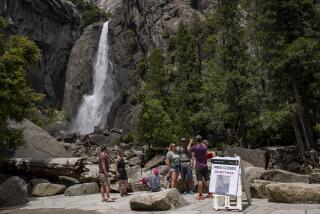Dunes Segment Opened to Recreational Vehicles
- Share via
The U.S. Bureau of Land Management on Friday opened all but a small portion of the Imperial Sand Dunes to recreational vehicle use, reversing a 3-year-old policy that had set aside a large portion of the dunes to protect fragile plant and animal species, including the desert tortoise.
In issuing its management plan for the 160,000-acre dunes east of San Diego, the BLM also for the first time established visitor targets to better manage peak holiday crushes. While the plan does not set a cap on the number of overnight visitors, it says that the area can safely accommodate at the most about 80,000 campers. At the same time, the BLM maintains it is prepared to deal with as many as 200,000 people during busy times such as Thanksgiving weekend, when extra law enforcement personnel will be on duty.
In total, 101,000 acres will now be open to unlimited off-road driving, while about 26,000 acres of designated wilderness will remain off limits to vehicles.
Imperial Dunes is the most popular off-road recreation area in the Southwest, but rowdy behavior during holiday weekends has drawn the ire of law enforcement officials as well as conservation groups.
Earlier this year, the California Off Highway Vehicle Commission denied the BLM more than $1 million in state funding, accusing the agency of poor management of the dunes.
“This plan is geared so that we won’t be overrun and overwhelmed,” said BLM spokeswoman Jan Bedrosian.
She said that when the dunes become too crowded, campers may be asked to move to less-populated areas. Bedrosian said the plan calls for increasing fees during peak times and expanding the reservation system.
The plan establishes a ranger station to handle an increased law enforcement presence, and calls for additional telephones, toilets, road grading, dust control, trash services and vendor areas.
Opponents of the new plan say it ignores scientific conclusions that off-road vehicles imperil the dunes’ protected species.
“We will challenge the Bush administration to protect the dunes, and we are confident we will prevail in court,” said Daniel Patterson, desert ecologist with the Center for Biological Diversity.
The new management plan opens 49,000 acres that had been closed to off-road vehicles but earmarks 33,000 acres as an area where sensitive plants and animals will be subject to careful monitoring. In that area, the plan limits vehicular use to 525 per day during the first year. No overnight camping will be permitted there.
More to Read
Sign up for The Wild
We’ll help you find the best places to hike, bike and run, as well as the perfect silent spots for meditation and yoga.
You may occasionally receive promotional content from the Los Angeles Times.







